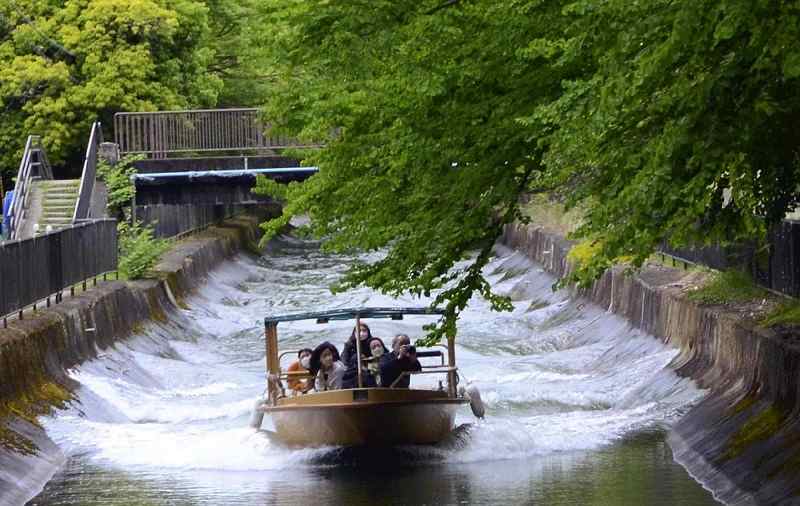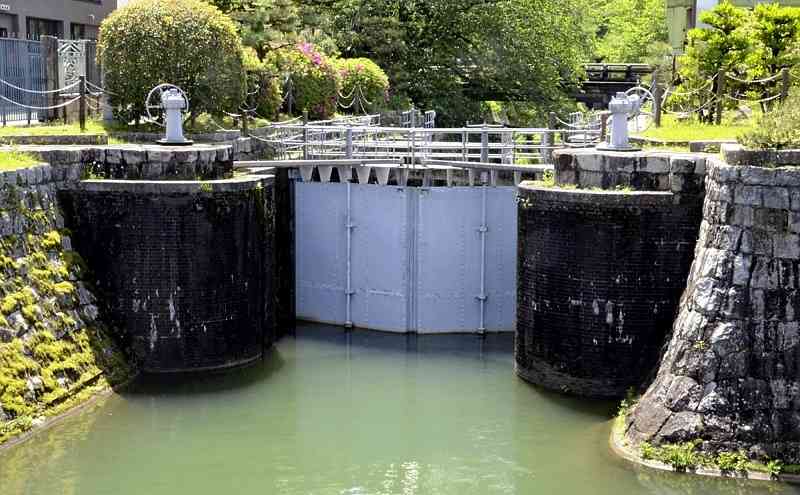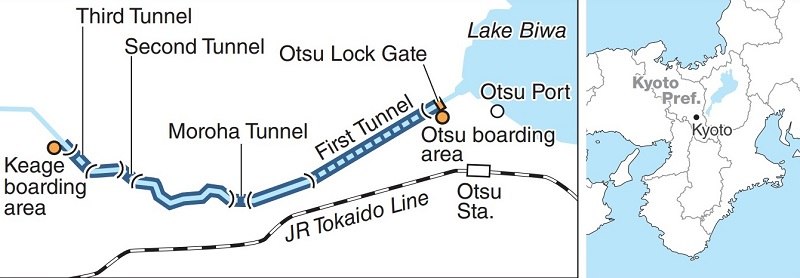
A sightseeing boat heads for Otsu against the current on the Lake Biwa Canal in Yamashina Ward, Kyoto.
11:35 JST, June 11, 2022
KYOTO — Five years ago, a historic canal linking the cities of Otsu and Kyoto was reopened to sightseeing cruise boats for the first time in 67 years. Dubbed the Lake Biwa Canal Cruise, there are now plans to extend the route to its namesake lake.
Prior to being halted due to the pandemic, the cruise had proved quite popular, operating at 95% capacity and attracting over 30,000 passengers drawn by the historic structures and natural beauty along the route. But even with the general reopening of the economy, sales have been sluggish this spring.
Currently, plans are underway to renovate the Otsu Lock Gate, which would allow the cruise route to be extended to Lake Biwa in order to enhance its appeal despite current economic difficulties.
Exceptional views
On a clear day in late April, I took the route from Kyoto to Otsu.
The canal was originally built in the 19th century to supply water from Lake Biwa to Kyoto.
Setting out from the Keage Boat Reservoir in Kyoto’s Yamashina district, we quickly enter the Third Tunnel. As the guide describes how the vessels were propelled manually through this tunnel by people using a rope, it takes me back to a different era.
Coming out of the tunnel, a refreshing wind brushes my cheek as we encounter a scenery of abundant greenery. It was fun exchanging waves with the local residents as they watched us make our way on the canal.
“My elderly father wanted to try it,” said a self-employed 50-year-old woman from Otsu who was accompanied by two family members. “I’ve felt an affinity with the canal since I was a child, but hearing the guide’s explanation, I now have a better understanding of it. It was like an amusement park attraction, and I enjoyed it more than I had expected.”
The route is about eight kilometers between Otsu and Keage. Prior to the pandemic, the operator was flooded with bookings because of the exceptional views — cherry blossoms in the spring, changing leaves in the fall — as well as the pleasant descriptions by the guide. There have been more than few repeat customers.
However, when a state of emergency was in effect during 2020 and 2021, the cruise was suspended. This spring, although there are no restrictions in place, the cruise is seeing fewer passengers from outside the region, most likely out of caution over the situation.
History over 130 years
The Lake Biwa Canal itself was built in 1890 as a means to revitalize industry in Kyoto, which had suffered a drastic drop in population amid the political and economic turmoil following the end of Tokugawa shogunate. It mainly served to supply water for agricultural usage and hydroelectric power generation.
Boat transportation on the canal began the following year. In those days, cargo boats from Lake Biwa could also go to Osaka by being transported to the Kamogawa river on an inclined railroad — called the Keage Incline — that ran from the Keage Boat Reservoir.
In addition to the cargo boats carrying rice and building materials such as bricks, sightseeing boats also plied the canal. However, due to an economic slump and the proliferation of other means of transportation such as railroads and automobiles, the service was ended in 1951.
In response to calls from local citizens and others hoping to reap the benefits of tourism, the mayors of Kyoto and Otsu participated in a test run in 2013, which greatly accelerated preparations for starting the sightseeing cruise.
In 2018, a council was formed among the Kyoto and Otsu municipal governments, the Keihan railroad company, Shiga Prefecture and others, and the cruise began operation for limited periods in the spring and autumn.
Automation of lock gate
The eastern starting point of the cruise is the aging Otsu Lock Gate, located just before the canal connects with Lake Biwa. Work has begun on renovating and automating the gate so that boats can smoothly pass through and continue to and from the lake.

The Otsu Lock Gate near Lake Biwa is undergoing renovations to automate it and make it easier for boats to pass through.
The lock’s purpose is to level out the 70-centimeter difference in the height of the water between Lake Biwa and the canal. However, more than 30 years have passed since the lock started operation, and the gate can only be opened and closed manually — a process that takes about 30 minutes. By automating the gate, boats will be able to pass through in just a few minutes.
Since the Lake Biwa Canal was designated as a Japan Heritage site in 2020, the project is eligible for government subsidies.
“If we don’t take advantage of this opportunity, it will mean the city will have to bear more of the burden, so it is not appropriate to put it off,” said an official of the Kyoto city water and sewerage bureau.
Kyoto will allocate a total of ¥468 million, including ¥188 million from the central government, for the project, which is expected to be completed by March 2023.
“The sight of the boat passing through a lock like on the Panama Canal will surely enhance the attractiveness of the cruise,” said a Kyoto government official.
— Cruise details

The cruise, starting from Otsu, which is at a higher elevation, goes with the current and takes about 55 minutes carrying a maximum of 12 passengers. Going the opposite direction from Keage, the boat uses a motor and takes about 35 minutes with a capacity of nine passengers. Reservations are required. Fares vary depending on the time of year and range from ¥5,000 to ¥8,000 per person. This year’s spring cruises will end on June 12.
Related Tags
"Features" POPULAR ARTICLE
-

Sanrio to Open Museum in Yamanashi Pref. Dedicated to Founder, Exhibits Include Hello Kitty, Other Characters
-

Autumn Foliage Surrounds Visitors to Tokyo’s Showa Kinen Park
-

My Daughter No Longer Speaks to Me, But I Want to See Her and My Grandchild
-

Kumamoto: Public Bath Refurbished as Library Where You Can Chat, Take Photos
-

Frozen Vegetables: Demand Rises for Convenient, Tasty Domestic Produce
JN ACCESS RANKING
-

Tokyo Economic Security Forum to Hold Inaugural Meeting Amid Tense Global Environment
-

Keidanren Chairman Yoshinobu Tsutsui Visits Kashiwazaki-Kariwa Nuclear Power Plant; Inspects New Emergency Safety System
-

Imports of Rare Earths from China Facing Delays, May Be Caused by Deterioration of Japan-China Relations
-

University of Tokyo Professor Discusses Japanese Economic Security in Interview Ahead of Forum
-

Japan Pulls out of Vietnam Nuclear Project, Complicating Hanoi’s Power Plans

























